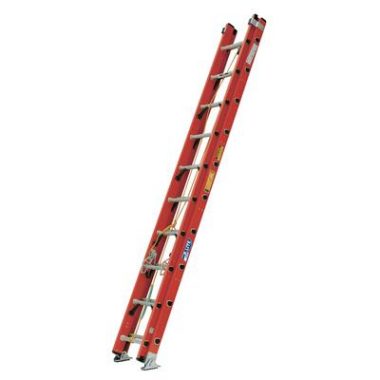
An extension ladder provides the easiest, most convenient way to reach high areas around your home, but with greater heights come greater chances for more serious injury. So be careful.
Our extension ladders come in a variety of sizes 24′, 32′, and 40′
Regardless of the step ladder size, you always want to keep the following safety tips in mind:
- To extend the ladder, first lay it on the ground with its feet braced against the house. Then raise the top end of the ladder and walk it upright hand over hand. Once the ladder is nearly vertical, grab a rung at about thigh-high, lift the ladder slightly, and walk its base back away from the house.
- Once the ladder is in position, grab the rope and raise the telescopic section of the ladder, known as the fly, to the desired height. Be sure that both rung hooks lock securely onto a rung of the ladder, then tie off the end of the rope to a lower rung.
- To set the proper ladder angle, use a 1:4 ratio: Divide the ladder height by 4, then move the ladder base that far from the house. For example, if the ladder is 24 feet tall, its base should be 6 feet away from the house.
- Both ladder feet should sit firmly on the ground. If one foot doesn’t make contact, don’t stack blocks of wood beneath it. Instead, dig some dirt out from beneath the other foot.
- Never stand an extension ladder on wet, muddy, icy, or snow-covered surfaces.
- Don’t stand higher than the fourth rung from the top.
- Never set up a ladder anywhere near electrical power lines.
- Always face the ladder when ascending and descending. And use both hands to grab the rungs—not the rails.
- If necessary, wear a tool belt or holster to carry tools and supplies. That way, you’ll have both hands free when climbing up and down.
- As with a stepladder, keep your hips within the vertical side rails. Don’t overreach to the left or right.

